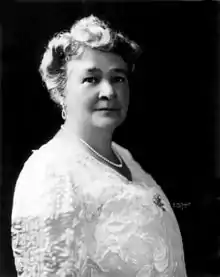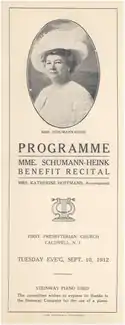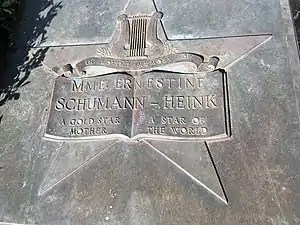Ernestine Schumann-Heink
Ernestine Schumann-Heink (15 June 1861 – 17 November 1936) was an Austrian-born German-American operatic contralto of German Bohemian descent.[1] She was noted for the flexibility and wide range of her voice.
Ernestine Schumann-Heink | |
|---|---|
.jpg.webp) Schumann-Heink in 1918 | |
| Born | Ernestine Amalie Pauline Rössler 15 June 1861 |
| Died | 17 November 1936 (aged 75) |
| Other names | Tina Rössler |
| Spouse(s) | Johann Georg Ernst August Heink
(m. 1882–1893)Curt Paul Schumann (m. c. 1895–1905) William Rapp, Jr.
(m. 1905–1915) |
| Children | August (1883–1918) Charlotte (1884–?) Henry (1886–1951) Hans Hugo Herman (1887–1916) Ferdinand (1893–1958) Marie (1896–?) George Washington (1898–1979) Walter Schumann |
| Parent(s) | Hans Rössler Charlotte Goldman |
| Signature | |
Early life
Ernestine Amalie Pauline Rössler was born on 15 June 1861 to a German-speaking family at Libeň (German: Lieben),[2] Bohemia, Austrian Empire, which is now part of the city of Prague, Czech Republic.[1] She was baptized Catholic five days later. Her father, who called his daughter "Tini",[3] was Hans Rössler. Before working as a shoe maker, he served as an Austrian cavalry officer. He had been stationed in northern Italy (then an Austrian protectorate), where he met and married Charlotte Goldman (Rössler), with whom he returned to Libeň.[4] Her maternal grandmother, Leah Kohn,[3] was of Hungarian Jewish.[5] descent and first prophesied Ernestine's successful career.[3]
When Ernestine was three years old, the family moved to Verona. In 1866, at the outbreak of the Austro-Prussian War, the family moved to Prague, where she was schooled at the Ursuline Convent. At war's end, the Roesslers moved to Podgórze, now part of Kraków, where she attended the St. Andreas Convent.[3] The family moved again to Graz when Ernestine was thirteen. Here she met Marietta von LeClair, a retired opera singer, who agreed to give her voice lessons.
In 1876, Ernestine gave her first professional performance (age 15) as alto soloist in Beethoven's Ninth Symphony in Graz.[3] Her operatic debut was on 15 October 1878 at Dresden's Royal Opera House, where for four seasons she played the role of Azucena in Il trovatore[6],and served as principal contralto when she was 17.[7]
First marriage
In 1882 she married Johann Georg Ernst Albert Heink (1854–1933), secretary of the Semperoper, the Saxon State Opera Dresden; this violated the terms of their contracts, and both had their employment abruptly terminated.[8] Heink took a job at the local customs house and was soon transferred to Hamburg. Ernestine remained in Dresden to pursue her career, and eventually rejoined her husband when she secured a position at the Hamburg Opera. She went on to have four children with Heink: August, Charlotte, Henry and Hans.[8][9]
Ernest Heink was again thrown out of work when Saxons were banned from government positions, and departed to Saxony to find work. Ernestine, pregnant, did not follow him; they were divorced in 1892 when Ernestine was thirty-one years old.[8] She came to the United States to make a brief foray into the Broadway theater, playing in Julian Edwards' operetta Love's Lottery, in which her performance was noted for the fact that she often broke off to ask the audience whether her English was good enough. She left the production after 50 performances and soon returned to opera.[10]
Her breakthrough into leading roles was provided when prima donna Marie Goetze argued with the director of the Hamburg opera. He asked Ernestine to sing the title role of Carmen, without rehearsal, which she did to great acclaim. Goetze, in a fit of pique, cancelled out of the role of Fidès in Le prophète, to be performed the following night, and was again replaced by Ernestine. Schumann-Heink replaced Goetze as Ortrud in Lohengrin the following evening, one more time without rehearsal, and was offered a ten-year contract.
In 1887, Ernestine sang Johannes Brahms' Alto Rhapsody under the direction of Hans von Bülow in a concert in Hamburg, with Brahms in attendance.[3][11] She was then engaged by Bülow to sing in a cycle of Mozart performances later that year. However, Ernestine had to withdraw from these performances due to the coincidence with the birth of her fourth child, Hans, in November of 1887. This withdrawal angered Bülow, and their relationship did not continue.[3]
Second marriage
After the divorce from her first husband, she married with Paul Schumann, an actor and director of the Thalia Theater in Hamburg in 1892.[12] Ernestine acquired a stepson, Walter, and had three more children with Paul: Ferdinand Schumann, Marie Schumann and George Washington Schumann. This last boy was born in New York City, named by her good-humored mother with suggestion of the doctor who delivered the baby.[3] One of their children, Ferdinand Schumann-Heink (1893–1958) was a prolific, though mostly unbilled, Hollywood character actor. It was a happy family.
Paul died in Germany, 28 November 1904.[13] While fighting a legal battle in Germany over her late husband's estate, she filed her United States naturalization papers on 10 February 1905, and became a U.S. citizen on 3 March 1908.
International career

Schumann-Heink performed with Gustav Mahler at the Royal Opera House, Covent Garden, during the Hamburg company's London season in 1892, and became well known for her performances of the works of Richard Wagner, forging "a long and fruitful relationship with [the Annual] Bayreuth [Wagnerian music Festival]" that "lasted from 1896 to 1914".[6]
Ernestine's first appearance at the Metropolitan Opera in New York City was in 1899, and she performed regularly there until 1932. She recorded the first of her many musical "gramophone" performances in 1900. Several of these early sound recordings originally released on 78 RPM discs have been reissued on CD format. Although there are some imperfections in her singing, her musical technique still leave a deep impression on the audience.
Third marriage
On 11 February 1905, Ernestine became an American citizen.[14] On 27 May 1905, in Chicago, Illinois, she married her manager William Rapp, Jr when she was forty-three.[8] She and her new husband lived on Grandview Avenue, North Caldwell, New Jersey in her "Villa Fides" from April 1906 to December 1911; she then moved to 500 acres (2 km²) of farm land located just outside San Diego, California[15] (in an area then known as Helix Hill – now known as Mt. Helix – in Grossmont), purchased by her in January 1910, where she would live for most of her life. Her residence there is still standing.
In 1909, she created the role of Klytaemnestra in the debut of Richard Strauss's Elektra, of which she said she had no high opinion, calling it "a fearful din".[16] Strauss was not entirely captivated by Schumann-Heink either; according to one story, during rehearsals he admonished the orchestra, "Louder! I can still hear Madame Schumann-Heink!"
She separated from her husband on 10 December, 1911. She filed for divorce in 1913.[17] They divorced in 1914 and the appeals court upheld the lower court decision in 1915.[18][19]
In 1915, she appeared as herself in the early documentary film Mabel and Fatty Viewing the World's Fair at San Francisco directed by Fatty Arbuckle, who also appears as himself in the film.
Charitable work and community support

While living at North Caldwell, New Jersey Schumann-Heink became interested in efforts to honor President Grover Cleveland. The future president was born in 1837 in nearby Caldwell, New Jersey, where his father, Rev. Richard Cleveland was minister of the First Presbyterian Church. On 10 September, 1912, Schumann-Heink performed a benefit concert at the church to raise money to purchase the adjacent Presbyterian Manse, Cleveland's birthplace. In 1913, the Grover Cleveland Birthplace Memorial Association (GCBMA) purchased the Manse and opened it to the public as a museum. Mme. Schumann-Heink became the first lifetime member of the GCBMA.
During World War I, Schumann-Heink supported the United States and its armed forces. She entertained the troops and raised money for Liberty Bonds, as well as "the Red Cross, knights of Columbus, Young Men's Christian Association, and Jewish War Relief, and to entertaining soldiers Throughout the United States"[20] in order to help wounded veterans. She toured the United States raising money for the war effort, although she had relatives fighting on both sides of the war – including her sons August Heink, a merchant sailor who had been impressed into the German submarine service, Walter Schumann, Henry Heink and George Washington Schumann, all in the United States Navy.
Later years
In 1926, she first sang Stille Nacht (Silent Night) (in both German and English) over the radio for Christmas. This became a Christmas tradition with US radio listeners through Christmas of 1935. In 1927, she performed in an early Vitaphone sound short film, possibly the only surviving footage of her singing. She lost most of her assets in the Wall Street Crash of 1929 and was forced to sing again at age 69.[21][22]
In 1926, then 65, she had begun a weekly radio program, in addition to announcing her plans to "teach forty American girls"; Schumann "spent considerable time advising women to forgo politics, smoking and unchaperoned dancing, and to devote themselves to bringing up children".[23] Her last performance at the Met was in 1932 performing Erda in Der Ring des Nibelungen, aged 71. In the movies of the 1930s, many a buxom opera singer/instructor/matron was modeled on her; see for instance 1937's Stage Door.
Death and legacy

Schumann-Heink died of leukemia on 17 November 1936 in Hollywood, California at the age of 75.[1][24] Her funeral was conducted by the American Legion at the Hollywood Post Auditorium, and she was interred at Greenwood Memorial Park in San Diego.[25] Her archive was donated to the Smithsonian Institution.[26] On Memorial Day, 30 May 1938, a bronze tablet honouring Schumann-Heink was unveiled by her granddaughter, Barbara Heink, at the Organ Pavilion in Balboa Park, San Diego.[27] The tablet featured a star that reads:
In loving Memory of Mme. Ernestine Schumann-Heink. A Gold Star Mother. A Star of the World
Operatic roles, with notable performances
| Role | Opera | Composer | Stage | Year |
|---|---|---|---|---|
| Azucena | Il Trovatore[28] | Verdi | Dresden Opera, Ernestine’s operatic debut[29] | 1878 |
| Brangäne | Tristan und Isolde[30] | Wagner | ||
| Carmen | Carmen | Bizet | Hamburg Opera, Ernestine’s first major role at the Hamburg opera[31] | 1886 |
| Fidès | Le Prophète[28] | Meyerbeer | Hamburg Opera[31] | 1886 |
| Ortrud | Lohengrin[28] | Wagner | 1886 | |
| Adriana | Rienzi[30] | Wagner | ||
| Amneris | Aida[30] | Verdi | ||
| Leonora | La Favorita | Donizetti | ||
| Katisha | The Mikado[30] | Gilbert and Sullivan, | ||
| Marthe | Faust | Gounod | ||
| Mary | Der Fliegende Hollander[30] | Wagner | ||
| Witch | Hansel and Gretel[30] | Humperdinck | ||
| Erda | Siegfried | Wagner | Theater Royal Drury Lane, London, Ernestine’s English debut[32] | 1892 |
| Prince Orlofsky | Die Fledermaus[30] | Strauss | 1894 | |
| Waltraute | Götterdämmerung | Wagner | Bayreuth, Ernestine’s first performance at the Bayreuth festival[28] | 1896 |
| Ortud | Lohengrin[28] | Wagner | Chicago Opera, Ernestine’s US debut[30] | 1898 |
| Ortud | Lohengrin[28] | Wagner | New York, Ernestine’s Metropolitan Opera debut[30] | 1899 |
| Clytemnestra | Elektra | Strauss | Dresden, world premiere[33] | 1909 |
| Erda | Rheingold | Wagner | Metropolitan Opera, New York, Ernestine’s final operatic performance[30] | 1932 |
References
- "Schumann-Heink, Great Singer, Dead. Native of Bohemia, She Won World-Wide Acclaim in Opera and Concerts". The New York Times. Associated Press. 18 November 1936.
Ernestine Schumann-Heink, beloved operatic and concert singer, died at her home in Hollywoodlands tonight at 7:21 o'clock (10:21 P. M., Eastern standard time). She was 75 years old
- The National cyclopaedia of American biography, being the history of the United States as illustrated in the lives of the founders, builders, and defenders of the republic, and of the men and women who are doing the work and moulding the thought of the present time. New York, J. T. White company.
- Lawton, Mary (1928). Schumann-Heink,the last of the Titans. New York. hdl:2027/mdp.39015029549139.
- "The Catalogue". katalog.ahmp.cz. Retrieved 20 May 2020.
- Notable American Women, 1607–1950: A Biographical Dictionary, Volume 3, Harvard University Press (1971), p. 242
- Shawe-Taylor, Desmond, Schumann-Heink, Ernestine, in Sadie, Stanley (editor), The New Grove Dictionary of Opera, New York, Grove (Oxford University Press), 1997, Volume Four, p. 255, ISBN 978-0-19-522186-2
- "Ernestine Schumann-Heink". The Musical Times. 77 (1126): 1138. 1936. ISSN 0027-4666. JSTOR 919782.
- Amero, Richard W. (1991). "Madame Schumann-Heink: San Diego's Diva". Southern California Quarterly. 73 (2): 157–182. doi:10.2307/41171570. JSTOR 41171570 – via JSTOR.
- "Sues Schumann-Heink's Son. Young Woman Asks $25,000 Because He Won't Marry Her". The New York Times. 7 March 1912.
- Gerald Martin Bordman, American musical theatre: a chronicle, Oxford University Press, 2001, p. 235.
- Hinrichsen, Hans-Joachim (1999). Musikalische Interpretation: Hans von Bülow. Stuttgart: Steiner. p. 492.
- Amero, Richard W. (1991). "Madame Schumann-Heink: San Diego's Diva". Southern California Quarterly. 73 (2): 157–182. doi:10.2307/41171570. JSTOR 41171570.
- "OPERA SINGER'S HUSBAND DEAD; Schumann-Heink Postpones Opening of Boston Engagement". The New York Times. 29 November 1904.
- "National Treasure". www.operanews.com.
- "Famous Songstress Praises California Home Ernestine Schumann-Heink Tells Why She Lives In California—and Coronado". cdnc.ucr.edu.
- Warrack, John and West, Ewan (1992), The Oxford Dictionary of Opera
- "Schumann-Heink Sues For Divorce. Grand Opera Star Files An Action In Chicago Charging Wm. Rapp, Jr., With Desertion". The New York Times. 23 December 1913.
- "Singer Gets Her Decree. Schumann-Heink Cleared and Costs Put on Husband". The New York Times. 1 July 1914.
- "Confirms Schumann-Heink Divorce". The New York Times. 6 October 1915.
- Amero, Richard W. (1991). "Madame Schumann-Heink: San Diego's Diva". Southern California Quarterly. 73 (2): 157–182. doi:10.2307/41171570. ISSN 0038-3929. JSTOR 41171570.
- "Madame Shumann-Heink, the diva of Grossmont | San Diego Reader". www.sandiegoreader.com. Retrieved 4 October 2020.
- "Schumann-Heink, Ernestine (Tini); geb. Rössler, geschiedene Heink, verwitwete Schumann, geschiedene Rapp, Künstlername Schumann-Heink". dx.doi.org. doi:10.1553/0x00284717. Retrieved 3 October 2020.
- Amero, Richard W. (1991). "Madame Schumann-Heink: San Diego's Diva". Southern California Quarterly. 73 (2): 157–182. doi:10.2307/41171570. ISSN 0038-3929. JSTOR 41171570.
- John Warrack and Ewan West, The Oxford Dictionary of Opera (1992)
- "Eulogized at Rites. American Legion Holds Service for Singer in Auditorium of Hollywood Post". The New York Times. 21 November 1936.
- "Children Get Estate Of Schumann-Heink. Will Gives Her Medals, Degrees, Diplomas and Music to the Smithsonian Institution". The New York Times. Associated Press. 25 November 1936.
- "Veterans see plaque unveiled honoring Mme. Schumann Heink". San Diego Union. 31 May 1938. p. 3.
- Lawton, Mary (1928). Schumann-Heink,the last of the Titans. New York. hdl:2027/mdp.39015029549139.
- Shawe-Taylor, Desmond, Schumann-Heink, Ernestine, in Sadie, Stanley (editor), The New Grove Dictionary of Opera, New York, Grove (Oxford University Press), 1997, Volume Four, p. 255, ISBN 978-0-19-522186-2
- Amero, Richard W. (1991). "Madame Schumann-Heink: San Diego's Diva". Southern California Quarterly. 73 (2): 157–182. doi:10.2307/41171570. JSTOR 41171570 – via JSTOR.
- “Ernestine Schumann-Heink.” The National Cyclopaedia of American Biography, James T. White and Company, 1970, p. 488-489.
- "Ernestine Schumann-Heink". The Musical Times. 77 (1126): 1138. 1936. JSTOR 919782 – via JSTOR.
- Murray, David. "Elektra (opera)". Grove Music Online. 2002. Oxford University Press. Date of access 3 October 2020.
Further reading
- Kennedy, Michael (2006), The Oxford Dictionary of Music, 985 pages, ISBN 0-19-861459-4
- Warrack, John and West, Ewan (1992), The Oxford Dictionary of Opera, 782 pages, ISBN 0-19-869164-5
External links
| Wikimedia Commons has media related to Ernestine Schumann-Heink. |
- Works by or about Ernestine Schumann-Heink at Internet Archive
- Schumann-Heink on cantabile-subito.de Biography with photos and audio samples
- Ernestine Schumann-Heink and actress Bette Davis 1930s
- Schumann-Heink in Popular Science Dec. 1956 (p.248) – Savings Bond advertisement
- Ernestine Schumann-Heink music collection digitized by Claremont College
Recordings
- Ernestine Schumann-Heink recordings at the Discography of American Historical Recordings.
- Ernestine Schumann-Heink: streaming audio at the Library of Congress.
